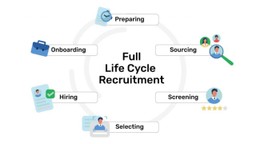In a highly competitive labor market, a company that has a good recruitment process stands a better chance in the “war for talent” than one that doesn’t have one. We simply call it the hiring process, but do you know that there are different terms referring to it? Like what? Like, as the end-to-end recruitment process, the full recruiting life cycle, and so on. These terms are used interchangeably because they all describe the same thing: the steps involved in recruiting candidates from the time you post a job until an offer is extended and accepted. By understanding the recruiting life cycle, a company can be more strategic in its hiring efforts and spruce up its recruitment process. Let’s go.
What Is the Full Recruiting Life Cycle?
A full life cycle of recruiting is also known as the end-to-end recruitment process in which an organization tracks down, vets, and hires the most appropriate candidate for a job opening. A typical lifecycle often covers a multitude of stages and leads a job applicant through each before coming to a hiring decision of giving an offer, re-considering as an imperfect candidate, or rejecting.
From the employers’ point of view, having a clear recruitment lifecycle in place helps the HR department to systemize their hiring process and identify the areas for improvement and automation. Furthermore, the full recruitment life cycle provides you with insights into the performance and productivity of your recruitment team as well as understanding the challenges they are encountering. As such, you can offer them support and guidance to make it easier for all.
In the perspective of a job applicant, it is also beneficial as the candidates can follow up on their job applications to know where they are in the hiring decision. This is more critical than we think it is, but it often tends to be overlooked in a lot of organizations. According to Glassdoor, 80% of candidates decide to drop out of the application process when they find it too long and complicated. By having a clear recruitment cycle, you can picture the whole process and weed out the unnecessary parts to make it more concise and less troublesome for both employers and job seekers.
The Big 6 Stages of a Full Life Cycle Recruiting
A full life cycle of recruitment varies by organization, but it can be broken down into the following stages:
#1 Planning & Preparation
The first stage of the cycle is all about gathering information from the hiring managers and figuring out what your company looks for in an employee. This step sounds simple, but it is actually not. After confirming the job requisition, the recruiters have to sit down with the HR manager for the vacancy intake – a strategy meeting to discuss the goals that should be achieved during the recruitment process. Based on the consented requirements of skills, scope of work, expected personality, and capabilities, the recruiters can do their job of crafting a clear and inclusive JD that accurately reflects the ideal candidates. The more deliberate the planning and preparation are, the smoother your hiring process will be later. Once you fully understand the vacancy that you are going to fill, it is time to move on to the next step.
#2 Job Posting & Candidate Sourcing
In this step, the job description will be converted into a job posting, which provides the job seekers with an overview yet comprehensive understanding of the opening position. When the job adverts are in place, and the recruitment channels have been decided, it is time to source talent before you can “filter gem from stone”.
In the 4.0 era of information and technology, employers and recruiters have to think outside the box to acquire talent than just the old-fashioned methods of job boarding. If not, you will be cast aside in the battle against other companies for top candidates. To save recruitment effort and cost, HR professionals are advised to embrace more creative ideas in talent acquisition. For example, you can leverage the social media platforms like LinkedIn and Facebook to approach more directly to job seekers. For example, you can simply start with diversifying the job portals. Also, you can leverage the social media platforms like LinkedIn and Facebook to approach more directly to job seekers. Or you can consider using employee referral programs and headhunting services to hunt down both active and passive candidates. Don’t forget about the internal recruitment when you have a great source of talent available right within your organization.
#3 Candidate Screening
Screening is always one of the most demanding and time-consuming stages of all. The ultimate goal of this stage is to identify and assess whether the applicants have what it takes to align them with the job opening. After this stage, all the most appropriate candidates will be shortlisted. Therefore, recruiters have to pay attention to the detail to vet the resumes and cover letters carefully. If recruiters entail more insights about the applicants, feel free to approach the candidates for a phone call or a quick video interview. Or, in the case when you find out “red flags” of job-hopping or employment gaps, don’t hesitate to arrange an in-person meeting to ask more questions.
In brief, think of the stage as a filter. Only the qualified candidates remain once it has been completed and move on to the following step. screening stage can be done manually, or it can be automated to be less stressful and more productive with the aid of pre-employment testing software. In addition to the hard or soft skills, recruiters can investigate the personality as well as interests of an applicant via surveys, questionnaires, or tests to speculate if he or she may become a good fit for your company. For example, you can consider bravoSURVEYS – an easy survey creator or bravoGROWTH – a personal reflection tool to explore one’s inner strengths and drive.
#4 Interviewing & Selecting
You have covered half of the recruitment life cycle, and this phase is about thorough interviews with the shortlisted candidates. Apart from what is written in the resumes, this is the time to evaluate a job candidate’s real performance and potential. Then, you can identify if a candidate is a right match for your organization in terms of core values and working style. The interview is not just about what the candidates say but also about how they behave. Also, don’t forget to take note of both verbal and non-verbal cues to better understand the job applicants.
During the interview process, it is important that you ask questions related to the job description and company culture, as well as behavioral questions, to test if a candidate has leadership qualities or problem-solving skills. For instance, you can inquire about how he/she handled difficult clients or resolved conflicts with colleagues in previous positions. Also, feel free to invite several members from different departments to attend the interviews so the results will be objectively measured.
#5 Decision-making
This is the most important stage within your whole recruiting life cycle. At this point, you must have got an idea of who to hire based on the insights and data you gain in the previous stages, but do not rush. To make an informed decision, involve your hiring manager or supervisor in this stage and ask for their input. Also, take into consideration the company budget, as well as the salary range that you’re willing to offer to the applicants. The next step is extending a job offer to your chosen candidate and waiting for his/her response.
For those who are not selected, it is advisable to inform them that they have not been successful in their applications. You can do this by sending them an email or giving them a call. While it is good to give feedback to all job applicants, make sure that you only provide constructive criticism to those who have reached the interview stage. A simple “Thank you for your application. Unfortunately, you are not what we are looking for at the moment” would suffice.
#6 Onboarding
Once the candidate has accepted the offer, recruiters can proceed to the last but not least process – onboarding. The onboarding process can be a bit overwhelming for both the employer and the new hire, but it’s important to make sure that the transition is as smooth as possible. The goal of the onboarding process is to help the new hire feel comfortable and confident in his or her new role. There are a lot of preparations to make in order to deliver the best employee experience for new hires from day 1, such as writing welcome emails, planning for an office tour, training, etc. To ensure that your new staff settle in well, you should have a new employee onboarding checklist with you so that you won’t miss any crucial step of welcoming newcomers. And this is the ending point of a typical recruiting life cycle. Please keep in mind that HR is an ever-changing landscape, so your optimal recruitment process now will not stay forever that way. Therefore, it is a must to keep an eye on the latest recruitment trends to constantly refine your hiring cycle in order to stay ahead of the competition.







